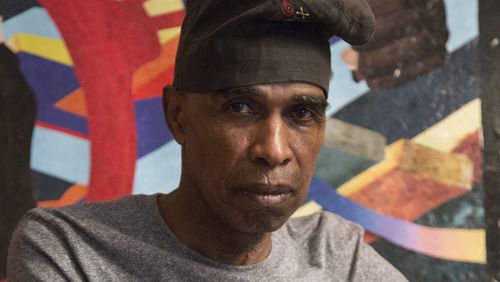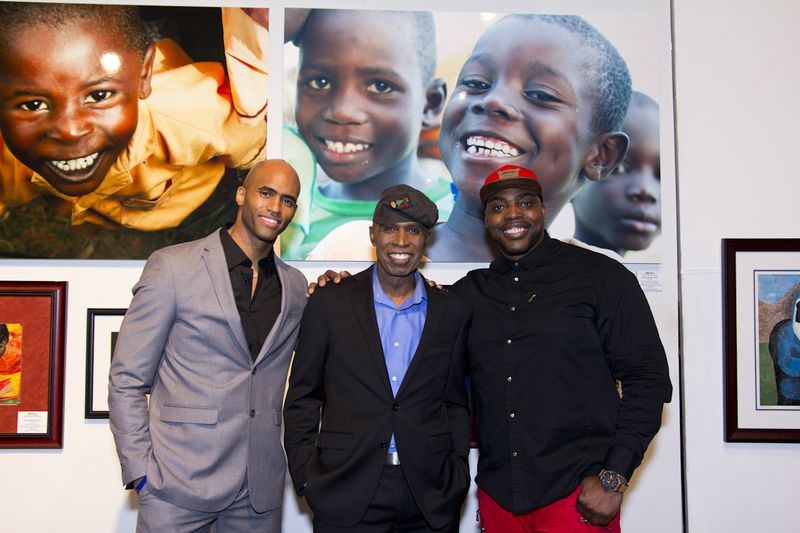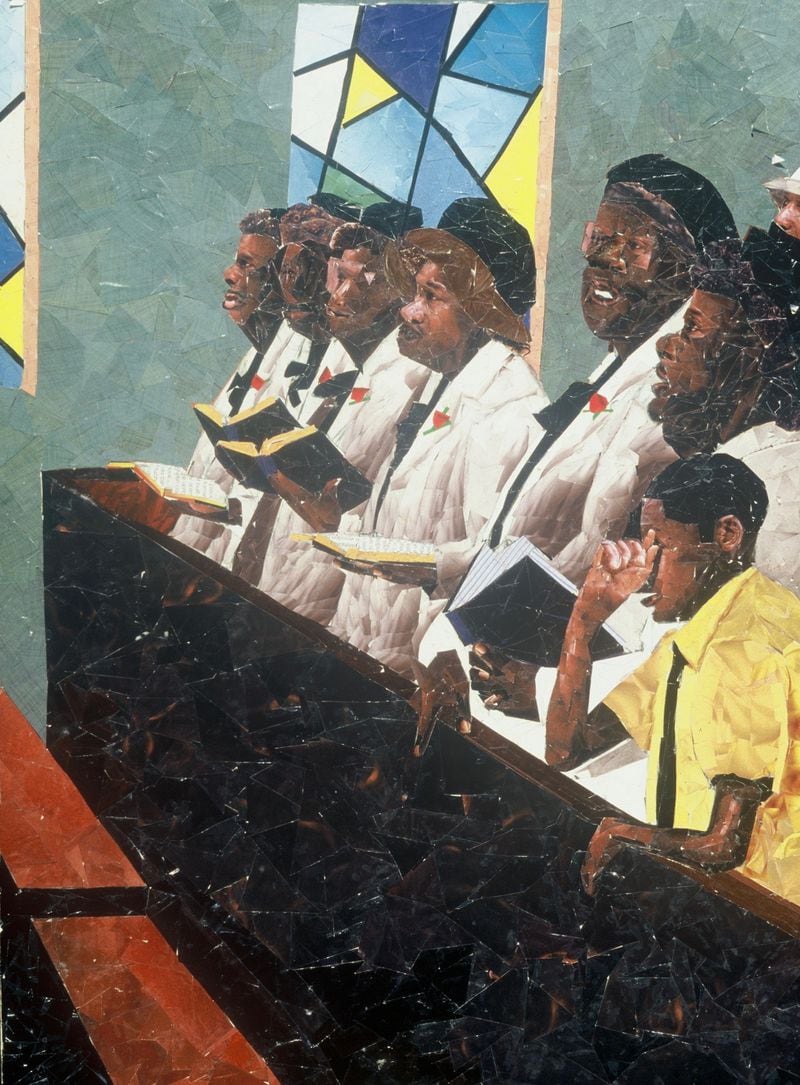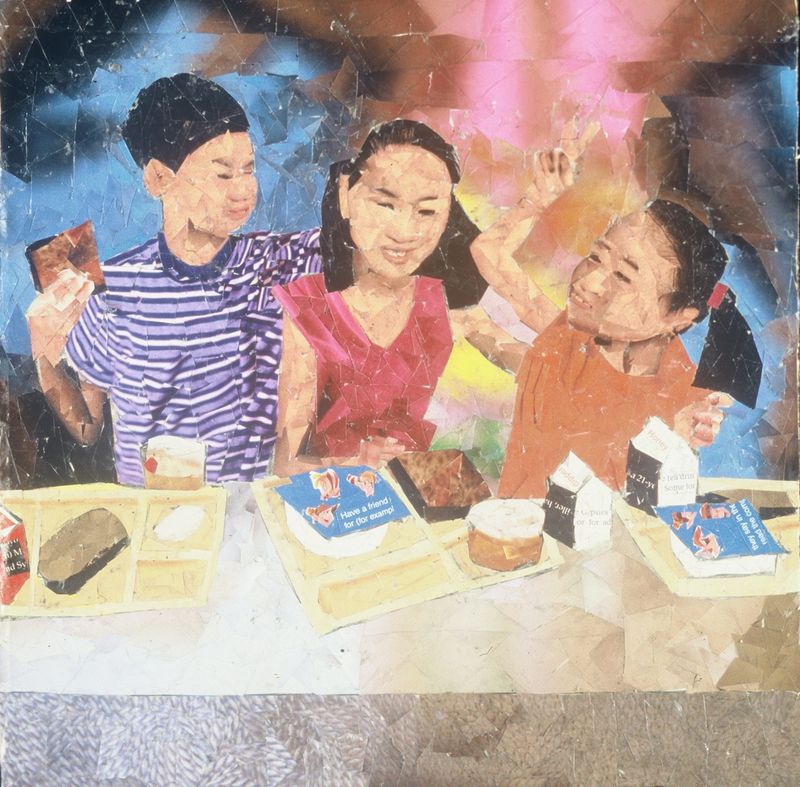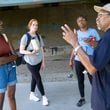As a boy growing up in the Fort Greene projects in Brooklyn, New York, Jim Hill would sit by the window for hours with a sketchbook drawing images of everything going on around him.
He had paper, but his father made it clear that paint and other art supplies would not take priority over feeding Hill and his six siblings.
So Hill used whatever he could find to make art -- burned matchsticks he used as charcoal, ball point pens and eventually paper from recycled magazines which he would cut into hundreds of tiny pieces, sort by color and assemble onto cardboard to create mosaics.
His larger mosaic works could take up to a year complete but despite the intense labor, the work didn’t always translate into sales. Even as he began making money in other careers as a model and teacher, Hill never stopped making art.
Inspired by a story he once heard from Rep. John Lewis, Hill created one large scale mosaic titled, “After Church BBQ.” The image depicts a black man being burned as a crowd of white men with smiling faces watch.
It was the image Hill chose to display during a tribute show to John-Michel Basquiat in Harlem in 2011. But to his dismay, the image was considered so offensive, it was covered with a cloth.
“It broke me up. They said ‘There are kids here. We don’t need that to be seen.’ It hurt because I was crying during the time I made the picture,” Hill said.
Hill packed up the picture and never put it on display again until he showed his Mosaic Master-Pieces collection for the first time this month in Atlanta in honor of Black History Month.
The month-long exhibit at the Douglas Stratton Photography Studio on Atlanta’s Westside features a number of Hill’s mosaic works many of which explore themes in black history and black culture.
“This is American history even though people call it Black history,” Hill said. “I was trying to create and show that there is a way out of this turmoil and hate. We have to find the way out through self-esteem.”
Religion, slavery, poverty and self-love are all subjects that Hill tackles in his work.
A trip to Ghana several years ago, inspired a series of photographs and mosaics that show children laughing and learning. He wanted people to see the faces of the children who were poor but unashamed, he said.
Another set of images shows children of different races that Hill met at shelters and feeding programs in New York.
Beginning with a drawing, Hill painstakingly places tiny bits of hand-cut paper onto cardboard until they explode into a fully formed picture. He has been asked to teach his technique to others, but he says it would be too hard to teach something he himself doesn’t fully understand.
“When you don’t know what you are going to do next, how are you going to teach anyone? If anyone wants to learn my technique they will have to sit and watch and then do it for themselves,” Hill said.
>> Listen to Jim Hill talk about his life, his art and his hopes to open a house for the homeless in Atlanta on the new accessAtlanta Podcast:
High school was the first time Hill had access to paints, canvases and other tools to create art. He was one of few black students at the school and credits his gift of gab with getting him through. He ended up earning an equal opportunity scholarship to attend St. Francis College after which he returned to Fort Greene to teach.
But Hill wanted to open his own school, so he started modeling to make more money. He became one of the top black male models in New York City earning up to $15,000 a day. He was in commercials and on billboards around the world. The ads portrayed him as a refined gentlemen with cigarettes, alcohol, a high-powered career and lots of women, but Hill remained at heart an artist.
His personal life often suffered at the expense of his dreams. Through multiple marriages and a feeling that something wasn’t right, Hill felt he needed to get his soul back. He moved into St. Anne’s Shelter in Brooklyn and began working with the homeless.
“The bottom line was this is what my life was. It was with the homeless and dealing with their struggle,” said Hill. When St. Anne’s closed, Hill decided to open his own shelter. He purchased a home in Brooklyn for $150,000 with plans to support women and children as well as men, but he admits he made a few missteps. Not requiring residents to sign contracts left him vulnerable to their whims.
By 2012, Hill had left it all behind and moved to Atlanta. He returned to teaching but he still hopes to open Jim Hill House, a shelter for the homeless.
So he continues creating his Mosaic Master-Pieces which retail as low as $1,500 and up to $50,000, in the hopes that he will raise enough money to fulfill his dream.
His latest projects include the recently completed “Birth of the Angry Black Woman,” a series on slavery and his new book, “Historical Blues” which features 100 of his artworks and the stories that inspired them. Hill also has plans to work with local organizations that are interested in using paper cutting to soothe anxiety and stress.
When people see his work, he wants them to see history, hope and self-esteem from one man’s perspective. “I had to go through all these walks to create those pictures,” he said. “They were all created out of my pain.”
accessAtlanta: Things to do in Atlanta by The Atlanta Journal-Constitution on Apple Podcasts
>> Listen on Google Play or Stitcher
Last week's podcast: Ryan Cameron interview on accessAtlanta podcast: 'I left it all on the table'
The AJC’s weekly accessAtlanta podcast brings you the stories that make our eclectic city one of a kind. Go with us behind the scenes for interviews with the people who create movies, music and art that’s making waves around the world. We’ll share some fun things to do in Atlanta over the next 10 days, too.
About the Author
